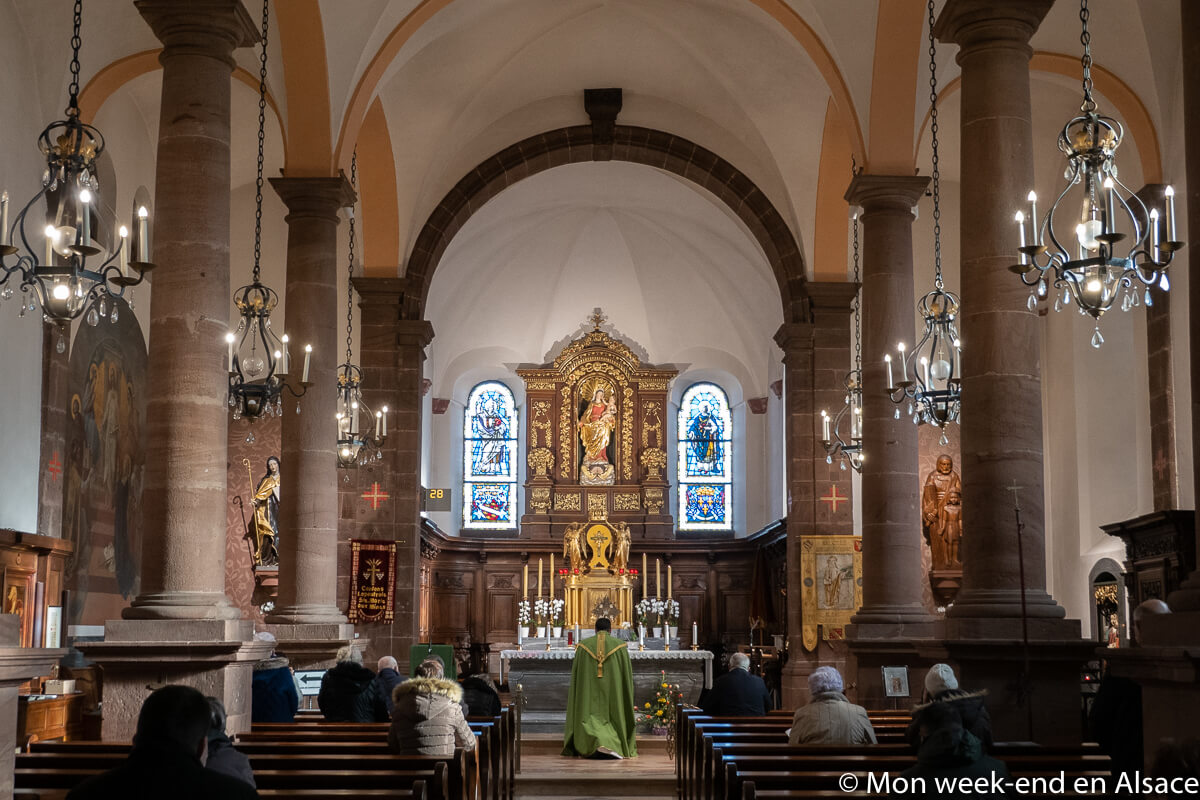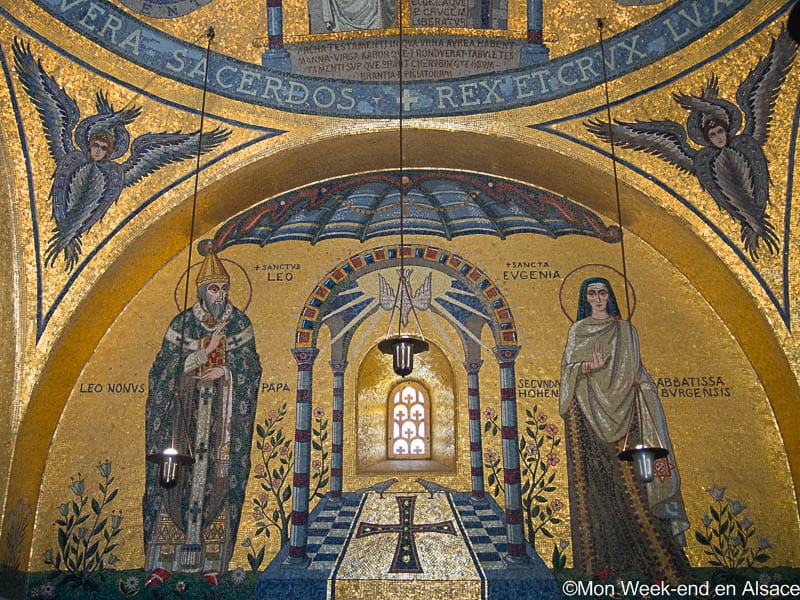Mont Sainte-Odile – A must-see in Alsace

Visiting the Mont Sainte-Odile is one of the must-dos of a visit to Alsace. Located on the heights of Obernai and Rosheim, it must be said that the place is impressive. There's a beautiful abbey here, with a superb view of the Alsace Plain and Black Forest on one side, and the Vosges mountains on the other. Mont Sainte-Odile is an important pilgrimage site, but many people also come here simply for the beauty of the surroundings. You don't have to be a believer to appreciate Mont Sainte-Odile!
My summary
I liked
- The view of the Alsace Plain, the Black Forest and the Vosges
- The tranquility of the place
- The beautiful buildings of the abbey of Mont Sainte-Odile
- The cohabitation between religious and visitors
I liked less
- Nothing!
What is the history of Mont Sainte-Odile?
History of Hohenbourg Abbey
In Celtic times, the mountain was called Altitona, which means “the high mountain”. For the Celts, it was already a place of worship and they built a fortress there, whose surrounding wall probably corresponds today to the famous “pagan wall”.
In the 7th century, the place belonged to the Duke of Alsace Adalric, the father of Sainte-Odile. He first had a residence built there, the Château de Hohenbourg. He rejected his daughter who was born blind and did not regain her sight until she was baptized at the age of 12. He will understand his destiny and will accept it only in front of the miracle of the opened rock (to know more about the legend of Sainte-Odile, “daughter of light”, it is by here).
He then built a monastery in 700, which he donated to Saint Odilia, who then transformed it into a convent. The place soon became a popular place of pilgrimage, especially for people with eye diseases. A national asset during the French Revolution, Mont Sainte-Odile was bought back by the bishopric of Strasbourg in 1854, which then restored it to its original monastic vocation.
Mont Sainte-Odile crash
Mount Sainte-Odile is unfortunately not only famous for its convent… Indeed, on January 20, 1992 took place the disaster of the Mount Sainte-Odile: an Airbus A320 of the company Air Inter crashed on the top of the Bloss, near the Mount Sainte-Odile. 87 people died and only 9 people survived this terrible air crash. A memorial has been installed at the site of the tragedy, with watchmen carved in sandstone by sculptor Annie Greiner.


How to visit the Mont sainte-Odile? Where to park?
Mont Sainte-Odile can be visited all year round free of charge. You can:
- drive to the abbey (parking P1)
- walk up from the P2 or P3 parking lots located below
- walk up from Ottrott along the Pilgrims’ Path (5km to go, about 1h30 walk)
- in season, take the bus (line 257) from Strasbourg or other cities
I strongly advise you to stop at the P2 or P3 parking lots on the road going up to Mont Sainte-Odile and to finish on foot, it is not very long. There is also a parking lot up there (P1) but it is small and therefore very often full.


What to visit
Sanctuary of Mount Sainte-Odile
Theabbey of Mont Sainte-Odile is superb and it is very pleasant to walk there: it is cooler than in the plain, the view is incredible, the place is peaceful and invites to relaxation. Do not forget to visit the small chapels of the abbey, whose walls and ceilings are decorated with beautiful mosaics, frescoes and gilding.
Inside the Mont Sainte-Odile, you will first discover the Cour des Tilleuls, then the Basilica, the Cour du Cloître dominated by a statue of Sainte-Odile, the Chapelle Saint-Jean Baptiste and its frescoes, the Chapelle de la Croix which is the oldest part of the convent, dating from the 12th century, the Chapel of Saint-Odile and the sarcophagus containing the relics of Saint-Odile, the Great Terrace and its superb view, the sundial dating from the 17th century, the Chapel of Tears, where you will be able to see some Merovingian tombs, and finally the Chapel of Angels, built in the 12th century.
The abbey also houses a hotel and a restaurant (although I wouldn’t recommend the restaurants, as they’re not very good). I really enjoyed seeing such a lively religious place, because of the cohabitation between religious and visitors.




Source Sainte-Odile
Located below the abbey, the Sainte-Odile spring is an important place of pilgrimage in Alsace. It can be reached by car or on foot from the road leading to the Mont Sainte-Odile. It is Odile who would have made it gush out by striking a rock with her stick in order to help an old blind man met there, and the miraculous spring would thus have effects on the diseases related to the eyes.
Pagan wall
At 10 minutes from the abbey, you can go to the pagan wall, an ancient enclosure whose origin is not known and is the subject of many hypotheses. To the uninitiated visitor, it is just an old wall… I walked past it without realizing it at first! It is in any case a pretty walk in the forest.
The pagan wall is eleven kilometers long and runs around the plateau of Mont Sainte-Odile. Formed by about 300 000 blocks of stone, sometimes up to 3 meters high and with a thickness varying from 1 to 2 meters, scientists have not been able to determine if it was a defensive or cultural enclosure and its construction remains an enigma.
Recent analyses date its construction to the 7th century (but this may also be the date of restoration), whereas its origins have long been traced back to prehistoric times. There is no lack of hypotheses, but they are only hypotheses: Oppidum of the Tène, refuge for the populations of the plain, sacred enclosure, delimitation of territory… the enigma of the pagan wall remains today whole and it is a big part of the charm of the stroll!

Hiking at the Mont Sainte-Odile
The visit does not end here! Many hiking trails start from the Mont Sainte-Odile. You can discover the Way of the Cross and the Grotto of Lourdes, take a tour of the rock on which the convent is built, the Sainte-Odile spring, as well as Niedermunster, the remains of the old abbey, the “sentier des Merveilles” and of course the famous pagan wall, which you can walk around. There are many hiking trails in the area, so you’ll be spoiled for choice! If you’re looking for a nice hike, Léa recommends the North Pagan Wall hike, one of her favorites!


Practical information
Rates
The visit is free. You can of course donate some money to help preserve the place. You will find all the information about the place on the website of the Mont Sainte-Odile.
Schedules
Mont Saint-Odile is open from 8am to 9pm. However, the chapels are only open until 7pm.
Access
By car
The address is as follows: Mont Sainte-Odile 67530 Ottrott. It is located at:
- 48 km from Strasbourg (about 50 minutes)
- 54 km from Colmar (about 55 minutes)
- 95 km from Mulhouse (about 1h15)
The parking is free.
By public transport
In season, the bus line n°257 of the Network 67 serves the Mont Sainte-Odile from Obernai. You will find here the timetable of the line n°257. You can also look at the Fluo website to find your route.

